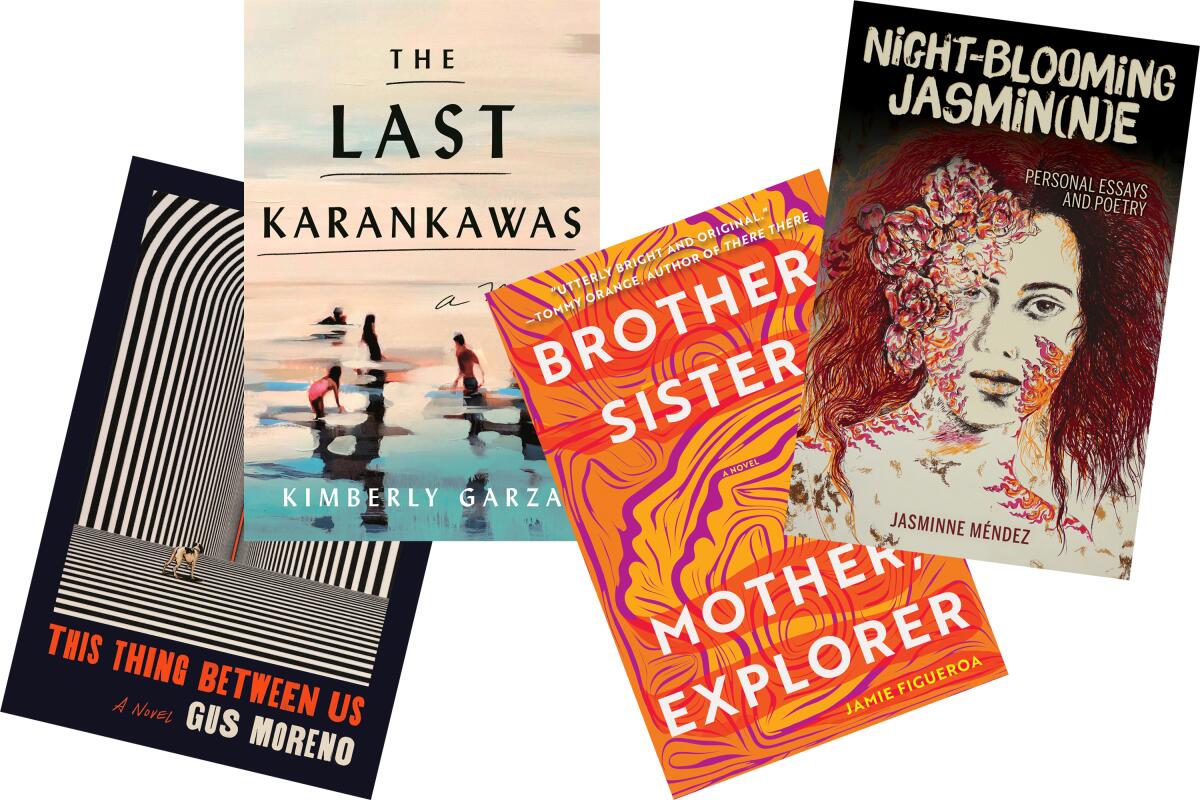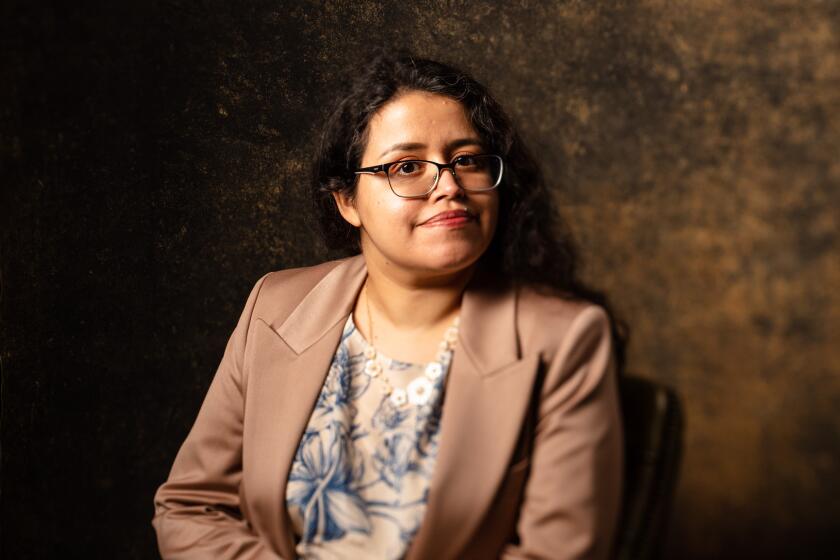11 books to read during Hispanic Heritage Month

- Share via
When I was a high school student in La Puente, the required readings in my English classes were anything but diverse. There were novels about poor English orphans and jilted Victorian brides. Our textbooks and anthologies were filled with epics of European men facing danger on the high seas or braving the wilds of the untamed American West. We were overwhelmingly brown and working class, the children of factory workers and janitors, auto mechanics and maids. I never saw myself in the books I was reading, which led me to believe that our stories were invalid, unworthy of being documented in books.
If you were Latino and wanted to write, you were told to look to John Steinbeck, Nathaniel Hawthorne and, of course, Shakespeare. In my earliest attempts at writing, the stories often took place in England or some other unspecified location in Europe. There were references to castles and moats, old countryside cemeteries and fog, lots of fog.
Not until after I graduated high school and enrolled in an English class at San Bernardino Valley College did I discover that writers of color did indeed exist and had been making significant strides in the world of literature.
In recognition of Hispanic Heritage Month, I’ve compiled a collection of works by Latino authors. Some names will be familiar, others new. Of course, no reading list is ever complete, no list ever able to capture the range of our collective experiences as a people. But I chose these, a mix of conventional and unorthodox narratives, to illustrate the scope of our literary capabilities.
“The Last Karankawas” by Kimberly Garza. The time is 2008. Hurricane Ike is about to batter the Gulf Coast, unraveling the lives of a group Mexican and Filipino residents in Galveston, Texas. Garza manages to expertly capture a range of voices in this stunning and elegiac polyphonic novel published in August. Expect great things from this debut writer. (Henry Holt, 2022)
“High-Risk Homosexual” by Edgar Gomez. This book examines Latinx queer identity in all its layers while incisively critiquing the notion of machismo as a cultural marker. In prose that is at turns funny and savvy as it is serious and contemplative, Gomez has written the memoir I wish I could have. (Soft Skull Press, 2022)
“Locas” by Yxta Maya Murray. Murray’s tale of two female gang members in East L.A. holding their own amid the violence and mayhem around them is searing and unapologetic, giving us a far more complicated depiction of Latino inner city life than what is typically offered. As more of Los Angeles experiences gentrification, Murray’s book provides us with a look back at what our neighborhoods once were. (Grove Press, 1997)
The Mexican-Canadian author of bestsellers ‘Mexican Gothic’ and ‘Velvet Was the Night’ was born and raised to be a genre-hopping, storytelling dynamo.
“This Thing Between Us” by Gus Moreno. Alexa and Siri are no match for Itza, the sinister voice-controlled smart assistant in Moreno’s heart-pounding horror novel, named a best book of the year by NPR and the New York Public Library. Read this one with the lights on. (MCD x FSG Originals, 2021)
“Their Dogs Came With Them” by Helena María Viramontes. The shadowy Quarantine Authority is but one of the many threats the four women at the heart of this novel must face. There’s also violence, displacement and the bulldozers tasked with flattening whole neighborhoods to make way for the construction of freeways. Viramontes’ literary prowess is on full display in this unvarnished look at East Los Angeles in the 1960s. (Atria Books, 2007)
“City of God” by Gil Cuadros. Cuadros was only 34 when he died of AIDS in 1996. This book, a fusion of fiction and poetry, documents the lives of young men exploring their burgeoning sexuality as the AIDS crisis ripped through the queer Chicano community of Los Angeles. It’s a vital and necessary read. (City Lights, 2001)
“The Barbarian Nurseries” by Héctor Tobar: It’s hard to pick one of Tobar’s books to highlight because he’s just that good. His second novel introduces Araceli, the live-in nanny of the dysfunctional Torres-Thompson clan. In Tobar’s hands, though, Araceli is more than just a criada, far more than a disembodied presence relegated to the background. Instead, he places her front and center as she sets off on an odyssey across Southern California. In doing so, Tobar, a former Times reporter, provides us with a panoramic vision of Los Angeles written with grace and compassion. (HarperCollins, 2011)
The latest from Ling Ma, Yiyun Li, Russell Banks and Namwali Serpell as well as exciting newcomers round out our critics’ most anticipated fall books.
“Night-blooming Jasmin(n)e: Personal Essays and Poetry” by Jasminne Mendez. In another hybrid text, Mendez chronicles her struggles as an Afro-Latina facing multiple chronic illnesses and a long and tangled legacy of distress and loss. But these are also accounts of hope and resiliency. She’s a talented writer whose star is on the rise. (Arte Publico Press, 2018)
“Brother, Sister, Mother, Explorer” by Jamie Figueroa. Rufina, with the help of her sister, devises a plan to save brother Rafa from ruining his life in this debut novel. Oh, and there’s also the ghost of their dead mother, Rufina’s missing child who crawls into her arms at night and an androgynous flea-infested angel. Her work is imaginative, lyrical and utterly captivating. (Catapult, 2021)
“Particulate Matter” by Felicia Luna Lemus. In Lemus’ first foray into nonfiction, the author chronicles a year in her marriage when the whole world turned upside down. Some pages are brief, containing only one or two words, but their emotional weight, and that of the entire book, packs such a punch readers will feel the sensation long after the end. (Akashic Books, 2020)
“Sana Sana” by Ariana Brown. The poems in Brown’s collection shed light on the experiences of her queer Afro-Mexican roots. As the title suggests, Brown seeks to heal, but it is a different kind of healing she covets. These are words written with empathy and fortitude, requiring your complete attention to be fully appreciated. (Game Over Books, 2020)
Espinoza is the Tomás Rivera Endowed Chair of creative writing at UC Riverside. His latest book is “Cruising: An Intimate History of a Radical Pastime.”
Book Club: If You Go
What: The L.A. Times Book Club is reading Silvia Moreno-Garcia‘s novel “The Daughter of Doctor Moreau,” in September, and she will be in conversation with Times editor Steve Padilla.
When: 6 p.m. PT Sept. 27
Where: This virtual event will livestream on Twitter, Facebook and YouTube. Get tickets and signed books on Eventbrite.
Book club newsletter: Join our community book club: latimes.com/bookclub
More to Read
Sign up for our Book Club newsletter
Get the latest news, events and more from the Los Angeles Times Book Club, and help us get L.A. reading and talking.
You may occasionally receive promotional content from the Los Angeles Times.









